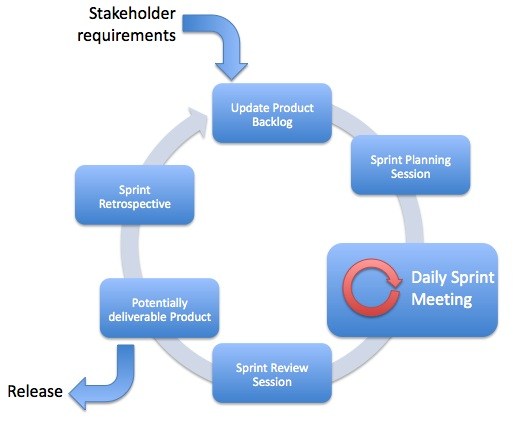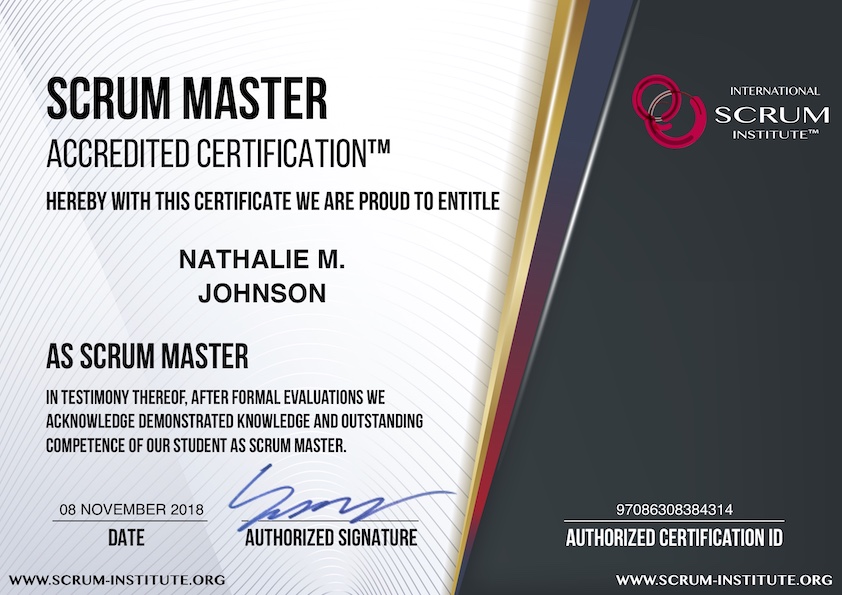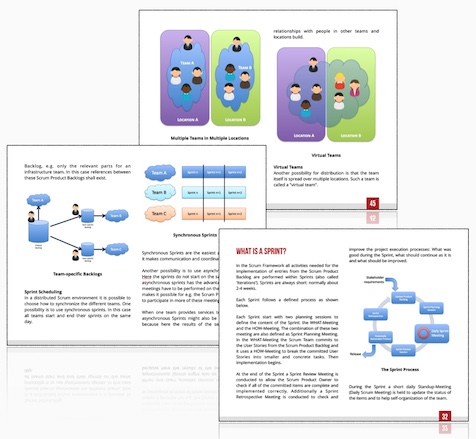Learn Scrum Framework Using Real World Case Study! This Might Surprise You!
Before Starting The First Sprint
Alex works as the Scrum Product Owner of a new
software development project. One of his first
tasks is to assess and find out requirements to
deliver business value his client is looking for.
He needs to make sure that his client will get the
correct software to achieve tangible business
results. He writes down the essential use cases
and discusses them with the architects, client
representatives, and other stakeholders from IT
and business units. (See our Scrum Example)
After assembling the high-level use-cases and
requirements, he writes them into the Scrum
Product Backlog and initiates an estimation and
prioritization session with the Scrum Team. As a
result of this session, all items in the Scrum
Product Backlog get an initial rough estimate
and priority.
During those sessions, Anna, the Scrum Master,
ensures that everyone speaks the same language.
So, the Scrum Product Owner, the Scrum
Team Members, and their stakeholders are
aligned with the anticipated goals.
So they have an adequate understanding of
potentially new concepts for them, such as Use Case,
Backlog, Sprint, and so on. And most importantly,
the Scrum software development and
delivery process is correctly applied in the
store.
Now Alex, the Scrum Product Owner, begins to
break down the high-level requirements into the
first draft of smaller-grained user stories. With
this list, he then calls for the first Sprint Planning
Meeting.
Sprint 1 - Day 0
During the Sprint Planning Meeting, Alex
presents the Scrum Product Backlog items from
the highest priority to the lowest. The Scrum
Team asks and clarifies open questions. For each
item, the team discusses if they have enough
25
capacity and the required know-how to develop
and deliver it. The Scrum Team needs to ensure
that all required human and technical
resources are in place before the start of the
Sprint. They need to confirm that all prerequisites
and dependencies are fulfilled, which could
be critical to delivering certain software features
successfully.
During Sprint Planning Meeting (What-Part),
the Scrum Team commit to complete the user
stories 1,2,3,6,7 and 8 until the end of the Sprint.
So these user stories are now moved from the
Scrum Product Backlog to the Sprint Backlog.
The user stories 4 and 5 cannot be accomplished
in this Sprint, as some prerequisite technical
infrastructure is not yet in place.
After the What-Part of the Sprint Planning
Meeting, Anna, the Scrum Master, calls the
Scrum Team to drill down how the team is
going to implement the committed user
stories (How-Part). The emerging tasks during
the How-Part of the Sprint Planning Meeting are
written down on the cards, and the team store
them into the Sprint Backlog. Now all members
of the Scrum Team are ready to select a task to
begin to work on.
Sprint 1 - Day 1
In the morning, the whole team gets together for
their Daily Scrum Meeting. Everyone gives a
brief and concise statement about what he or
she has done so far, updates the estimates of
remaining work on the cards of the Sprint
Backlog. Everyone tells what he or she is
planning to do today, and reveals if there are any
impediments which hinder them from processing
any tasks.
Today one of the Scrum Team members,
Melinda, informs the Scrum Team that she has a
problem with the license of the integrated
software development environment she is using.
Anna, the Scrum Master, checks if other team
members have the same problem and confirms
that she'll take care of this impediment after the
meeting. After about 15 minutes of this Daily
Scrum Meeting, everyone goes back to work.
After this meeting, Anna updates the Sprint
Burn down Chart to visualize the progress of
work during this Sprint. Then she calls the
software vendor, orders the missing license, and
delivers it to Melinda.

Introduction to Scrum
A Real World Example (Case Study ) across
various Scrum Phases and Sprints
Sprint 1 - Day 2
In the morning, the whole team gets together
again for their Daily Scrum Meeting. In the
afternoon, a member of the Scrum Team, James,
has uncertainty about the expected outcome of
one of the user stories. He calls Alex, Scrum
Product Owner, and they discuss this user story
to ensure that James properly understands it.
After Alex gets informed and confident about
how to proceed with this user story, he continues
working on its implementation.
Sprint 1 - Day 6
The days starts again with the Daily Scrum
Meeting of the team. Anna, the Scrum Master,
notices this morning that the meeting tends to
take more than 15 minutes. The Scrum Team
members are engaging with a discussion
regarding the optimization of some database
queries. Anna reminds the team that the Daily
Scrum Meetings are not meant to do the
work, but formally aligning the team about
the work and bringing them on the same
page.
After the Daily Scrum Meeting, Alex (Product
Owner) informs Anna (Scrum Master) that the
client brought up several new requirements that
may potentially impact the ongoing Sprint and
the subsequent Sprints. Anna politely reminds
Alex that the Scrum Team is unable to pick up
these requirements during the current Sprint
as the team has already committed to the
scope (user stories) of this Sprint. And yet,
Anna calls a Backlog Refinement Meeting for
the afternoon so that Alex can inform the team
about these new requirements.
During this meeting, the group supports Alex to
figure out where these user stories fit the
overall development plan of the software,
their initial task break-down, estimates, and
priorities.
Sprint 1 - Day 10
Finally, that's the last day of this first Sprint.
Anna, the Scrum Master, invites the Scrum Team
for the Sprint Review Meeting. The team has
prepared a non-production server with the latest
version of the shippable software increment they
created.
Alex, the Scrum Product Owner, and Mr. Rich,
one of the client stakeholders, sit in front of an
instance of a graphical user interface of this
software. They validate if the implementation
meets the expectations and if the team documented
details regarding the current level of
application adequately.
At the end of the Sprint Review Meeting, Alex
concludes:
- The team delivered user stories 1,2,6 and 7 as
committed and expected.
- The team couldn't finish the user story 3 on
time, and they didn't demonstrate this user
story at all. So, the remaining tasks of this user
story are shifted to this next Sprint.
- The user story 8 did not fulfill some of its
Definition of Done (DoD) criteria. This user
story is moved to the next Sprint, so the team
can define and complete the associated tasks
to satisfy the DoD of this user story later.
Alex, the Scrum Product Owner, and Mr. Rich, the
client stakeholder, shortly debrief the Scrum
Team about the upcoming changes and challenges
about the software requirements and the
direction of the overall strategy about this
software should be going. Mr. Rich thanks the
Scrum Team for their efforts and commitment
and leaves the room.
After the completion of the Sprint Planning
Meeting, the Scrum Team sits together for the
Sprint Retrospective Meeting. During this
meeting, they discuss what went well during the
Sprint and what could be improved, so that the
likelihood of failed commitments like it happened
with user stories 3 and 8 will reduce in the next
Sprints. One of the hurdles identified from the
Sprint Retrospective Meeting is that the team do
not know enough about the overall system
architecture. Anna, the Scrum Master, takes over
the task of bringing a system architect on board
to coach and guide the team at the beginning of
the next Sprint.
Sprint 2 - Day 1
Alex, the Scrum Product Owner, keeps on adding
new requirements to the Scrum Product Backlog
based on his recent client meetings. Moreover,
he improves the way he articulated DoD of user
story 8, so the Scrum Team can better envision
the expected outcome from this user story.
Alex then invites the team for the Sprint Planning
Meeting for Sprint 2. The Scrum Team discuss
and commit to user stories with the guidance of
Anna, the Scrum Master, and subsequently, the
second Sprint begins.
Share It With Your Colleagues and Friends to Help Them Learn:
Learn Scrum Framework Using Real World Case Study! This Might Surprise You!
|
|

|

|

|

|
|
 SCRUM INSTITUTE™
SCRUM INSTITUTE™






